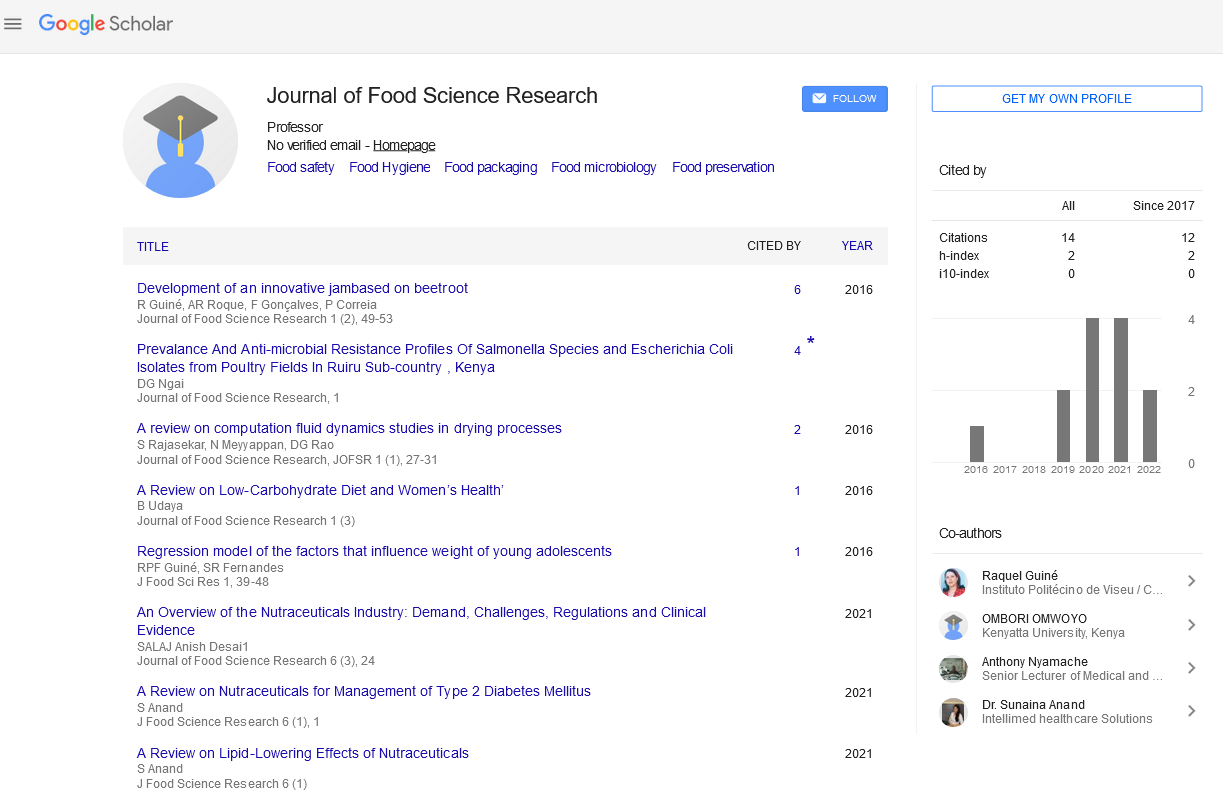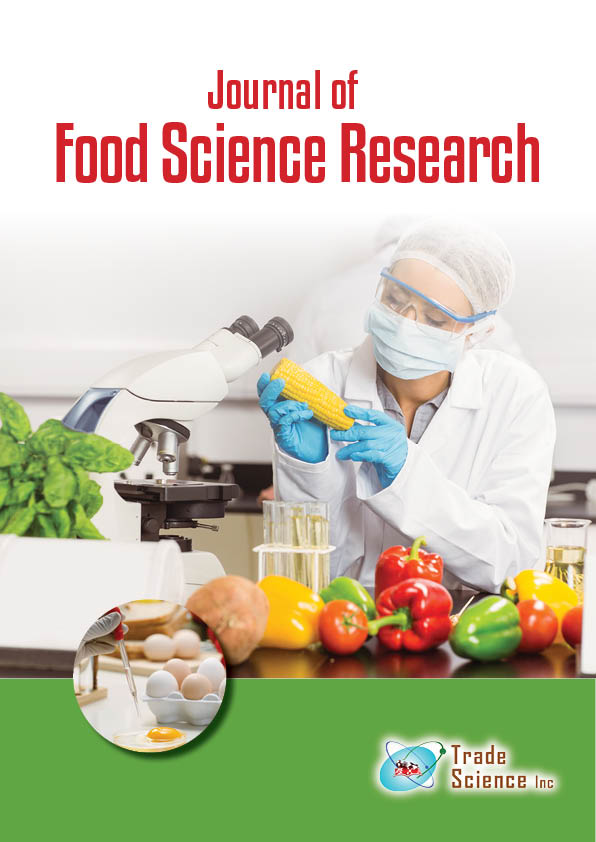Editorial
, Volume: 6( 6)Food Preservation by Using Traditional Techniques and Modern Industrial Techniques
Food preservation procedures include those that limit the growth of germs like yeasts (although other methods work by adding harmless bacteria or fungus to the food) and reduce the oxidation of lipids that produce rancidity. Processes that prevent aesthetic deterioration, such as the enzymatic browning reaction in apples after they are chopped during meal preparation, are examples of food preservation. Food waste can be decreased by preserving food, which is an important approach to lower production costs and improve food system efficiency, improve food security and nutrition, and contribute to environmental sustainability Many food preservation systems combine many food preservation methods. Boiling (to lower the fruit?s moisture content and kill bacteria, for example), sugaring (to inhibit re-growth), and sealing in an airtight container are all steps in the process of preserving fruit by converting it into jam (to prevent recontamination). The quality of food and food systems is affected differently by different food preservation methods. When compared to modern techniques of food preservation, several old methods have been demonstrated to have a lower energy input and carbon footprint. Some food preservation procedures are known to produce carcinogens. Processed meat, defined as meat that has been salted, cured, fermented, or smoked, was classed as ?carcinogenic to humans? by the World Health Organization?s International Agency for Research on Cancer in 2015. Traditional techniques Burial Food can be preserved by burying it due to a multitude of variables including absence of light, oxygen, cool temperatures, pH level, and desiccants in the soil. Burial can be used in conjunction with other techniques like salting or fermentation. Most foods can be stored in sand, which is highly dry and salty (therefore a desiccant), or in frozen soil. Many root vegetables are extremely resistant to deterioration and only require storage in cool, dark circumstances, such as burial in the ground or in a storage clamp (not to be confused with a root cellar). Cabbage was traditionally buried during Autumn in northern US farms for preservation. Some methods yield crunchy sauerkraut, while others produce sauerkraut. Meat is sometimes buried under conditions that allow it to be preserved. The heat can kill microorganisms, the dry ash can desiccate, and the dirt can block oxygen and further contamination if buried on hot coals or ashes. When buried in a cold environment, the soil works as a refrigerator or, in permafrost conditions, a freezer. Rice may be stored effectively by burying it underground in Orissa, India. During the dry season, this method allows you to keep for three to six months. Bog butter has been used to preserve butter and related items in Irish peat bogs for millennia. Century eggs are historically made by immersing eggs in alkaline mud (or another alkaline substance), which causes them to ferment ?inorganically? rather than rotting. Fermentation protects them while also breaking down some of the more complex, less delicious proteins and lipids into simpler, tastier proteins and fats. Cooling Cooling slows the growth and reproduction of microbes, as well as the action of enzymes that cause the food to decay. Commercial and household refrigerators revolutionised many people?s diets in the Western world by allowing food like Corresponding Author: Ludovica Daqun, Department of Food Science & Human Nutrition, Agricultural University of Athens, 11855 Athens, Greece, E-mail: ludovicadaqun@aua.gr Received date: November 08, 2021; Accepted date: November 22, 2021; Published date: November 30, 2021 www.tsijournals.com fresh fruit, salads, and dairy items to be properly preserved for longer periods of time, especially during hot weather. Root cellars and iceboxes were used to keep food cool before the invention of artificial refrigeration. Rural folk frequently cut their own ice, whereas city and town dwellers frequently relied on the ice trade. Root cellaring is still popular today among those who care about a variety of things, such as local food, heirloom crops, traditional home cooking techniques, family farming, frugality, self-sufficiency, organic farming, and so forth. Fermentation Specific microorganisms are used in some foods, such as many cheeses, wines, and beers, to prevent deterioration from other less-beneficial microbes. These microbes keep diseases at bay by making acid or alcohol, which makes the environment poisonous for themselves and other microbes. Starter microorganisms, salt, hops, controlled (typically cool) temperatures, and controlled (usually low) oxygen levels are all examples of fermentation methods. These techniques are used to establish the exact controlled circumstances needed to support the desirable organisms that produce food fit for human consumption. The microbial conversion of carbohydrates and sugars into alcohol is known as fermentation. Fermentation can not only make alcohol, but it can also be used to preserve food. Fermentation can also improve the nutritional value and taste of foods. Drinking water, for example, was hazardous in the middle Ages because it frequently carried viruses that could spread sickness. The boiling process used in the brewing of beer destroys any bacteria present in the water that could make people sick. Furthermore, the water now has minerals from the barley and other ingredients, and the bacteria can generate vitamins throughout the fermentation process. Freezing Freezing is also one of the most widely utilised methods for preserving a wide range of foods, both commercially and domestically, including prepared items that would not have required freezing in their unprepared state. Potato waffles, for example, can be frozen, but potatoes can be stored in a cold, dark spot for months. In many countries, cold stores provide large-volume, long-term storage for strategic food reserves kept in the event of a national disaster. Heating Heating to temperatures which are sufficient to kill microorganisms inside the food is a method used with perpetual stews. Modern Industrial Techniques Irradiation Food irradiation is the process of exposing food to ionising radiation. Beta particles (high-energy electrons) and gamma rays are two forms of ionising radiation that can be used (emitted from radioactive sources such as cobalt-60 or cesium-137). Irradiation kills germs, moulds, and insect pests, slows fruit ripening and spoilage, and induces sterility at higher dosages. The process is similar to pasteurisation; however, because the product is not heated, it is sometimes referred to as ?cold pasteurisation.? Irradiation has the potential to make low-quality or contaminated foods marketable. Food irradiation has been pronounced ?wholesome? by national and international expert bodies and UN institutions such as the World Health Organization and the Food and Agriculture Organization support it. Consumers may have a bad perception of irradiated food because they believe it is radioactive; however, irradiated food is not and never will be radioactive. Food irradiation has also been criticised by activists for other reasons, including as the argument that it can be used to sterilise contaminated food without addressing the underlying cause of the contamination. International legislation on whether or not food can be irradiated differs from country to country, ranging from no regulation to a complete ban. Biopreservation The use of natural or controlled micro biota or antimicrobials to preserve food and extend its shelf life is known as bio preservation. Bio preservation uses beneficial bacteria or the fermentation products produced by these bacteria to control deterioration and render pathogens inactive in food. It?s a non-harmful ecological technique that?s gaining popularity. LAB bacteriocins are becoming an important component of hurdle technology. They can efficiently prevent spoilage bacteria and other diseases, as well as impede the activities of a wide range of organisms, including innately resistant Gram-negative bacteria, when used in conjunction with other preservation approaches.Abstract
Food preservation procedures include those that limit the growth of germs like yeasts (although other methods work by adding harmless bacteria or fungus to the food) and reduce the oxidation of lipids that produce rancidity. Processes that prevent aesthetic deterioration, such as the enzymatic browning reaction in apples after they are chopped during meal preparation, are examples of food preservation. Food waste can be decreased by preserving food, which is an important approach to lower production costs and improve food system efficiency, improve food security and nutrition, and contribute to environmental sustainability Many food preservation systems combine many food preservation methods. Boiling (to lower the fruitâ??s moisture content and kill bacteria, for example), sugaring (to inhibit re-growth), and sealing in an airtight container are all steps in the process of preserving fruit by converting it into jam (to prevent recontamination). The quality of food and food systems is affected differently by different food preservation methods. When compared to modern techniques of food preservation, several old methods have been demonstrated to have a lower energy input and carbon footprint. Some food preservation procedures are known to produce carcinogens. Processed meat, defined as meat that has been salted, cured, fermented, or smoked, was classed as â??carcinogenic to humansâ? by the World Health Organizationâ??s International Agency for Research on Cancer in 2015.

